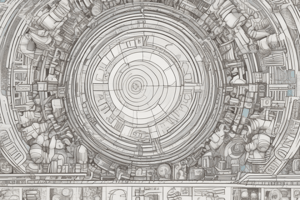Podcast
Questions and Answers
What are tangible products and provide two examples?
What are tangible products and provide two examples?
Tangible products are physical items that can be touched or owned. Examples include electronics and clothing.
Describe the primary focus during the growth stage of the product lifecycle.
Describe the primary focus during the growth stage of the product lifecycle.
During the growth stage, the primary focus is on increasing sales and expanding the customer base. This involves enhancing market acceptance.
What role does customer feedback play in identifying key products or services?
What role does customer feedback play in identifying key products or services?
Customer feedback helps gauge satisfaction and demand, guiding businesses in identifying which products resonate with consumers.
Differentiate between durable goods and consumable goods with examples.
Differentiate between durable goods and consumable goods with examples.
What is the impact of technology on key products or services?
What is the impact of technology on key products or services?
Explain how market demand affects the offerings of a business.
Explain how market demand affects the offerings of a business.
Why is understanding the competitive environment important for identifying key products?
Why is understanding the competitive environment important for identifying key products?
What is meant by brand identity in the context of key products or services?
What is meant by brand identity in the context of key products or services?
Flashcards are hidden until you start studying
Study Notes
Key Products or Services
-
Definition: Core offerings by a business that fulfill customer needs and contribute to revenue.
-
Types:
- Tangible Products: Physical items that can be touched or owned.
- Examples: Electronics, clothing, food.
- Intangible Products: Non-physical offerings that provide value.
- Examples: Software, consulting services, digital content.
- Durable Goods: Long-lasting items, typically used over time.
- Examples: Appliances, vehicles.
- Consumable Goods: Items intended for immediate use or consumption.
- Examples: Food, beverages.
- Tangible Products: Physical items that can be touched or owned.
-
Services: Activities performed for a customer that result in a benefit.
- Examples: Healthcare, education, maintenance services.
-
Product Lifecycle:
- Introduction: New product launches, marketing focus on awareness.
- Growth: Increasing sales, market acceptance, and customer base expansion.
- Maturity: Market saturation, sales stabilize, focus on differentiation.
- Decline: Decreasing sales, potential product discontinuation or innovation.
-
Factors Influencing Key Products/Services:
- Market Demand: Customer preferences and trends.
- Competition: Rival offerings and pricing strategies.
- Technology: Innovations that affect product development and delivery.
- Regulatory Environment: Compliance with laws and regulations impacting products.
-
Identifying Key Products/Services:
- Customer Feedback: Surveys and reviews to gauge satisfaction and demand.
- Sales Data: Analyzing sales performance to determine popular products.
- Market Research: Understanding industry trends and customer needs.
-
Importance of Key Products/Services:
- Revenue Generation: Primary source of income for businesses.
- Brand Identity: Shapes customer perceptions and loyalty.
- Competitive Advantage: Unique offerings can differentiate from competitors.
-
Examples of Key Products/Services in Different Industries:
- Technology: Smartphones, cloud services.
- Healthcare: Medical devices, health insurance.
- Retail: Apparel lines, online shopping experiences.
- Automotive: Electric vehicles, auto financing services.
Key Products or Services
- Core offerings that fulfill customer needs and contribute to a business's revenue.
Types of Key Products
- Tangible Products: Physical items that can be owned, such as electronics, clothing, and food.
- Intangible Products: Non-physical offerings providing value, including software, consulting services, and digital content.
- Durable Goods: Long-lasting products typically used over time, like appliances and vehicles.
- Consumable Goods: Items intended for immediate use or consumption, such as food and beverages.
Services
- Activities performed for customers that lead to a benefit, with examples including healthcare, education, and maintenance.
Product Lifecycle Stages
- Introduction: Focus on awareness during new product launches.
- Growth: Characterized by increasing sales and expanding customer base.
- Maturity: Market saturation occurs, leading to stabilized sales and emphasis on differentiation.
- Decline: Sales decrease, prompting potential discontinuation or innovation.
Influencing Factors
- Market Demand: Driven by customer preferences and trends.
- Competition: Affected by rival offerings and pricing strategies.
- Technology: Innovations impacting product development and delivery.
- Regulatory Environment: Compliance with laws affects product operation and offerings.
Identifying Key Products/Services
- Customer Feedback: Gathered through surveys and reviews to assess satisfaction and demand.
- Sales Data: Analyzed to identify popular products and understand sales performance.
- Market Research: Involves understanding industry trends and customer needs to inform product offerings.
Importance of Key Products/Services
- Revenue Generation: Serve as the primary source of income for businesses.
- Brand Identity: Shape customer perceptions and loyalty towards the business.
- Competitive Advantage: Unique offerings differentiate a business from its competitors.
Examples Across Industries
- Technology: Key products include smartphones and cloud services.
- Healthcare: Emphasizes medical devices and health insurance.
- Retail: Features apparel lines and online shopping experiences.
- Automotive: Focuses on electric vehicles and auto financing services.
Studying That Suits You
Use AI to generate personalized quizzes and flashcards to suit your learning preferences.




